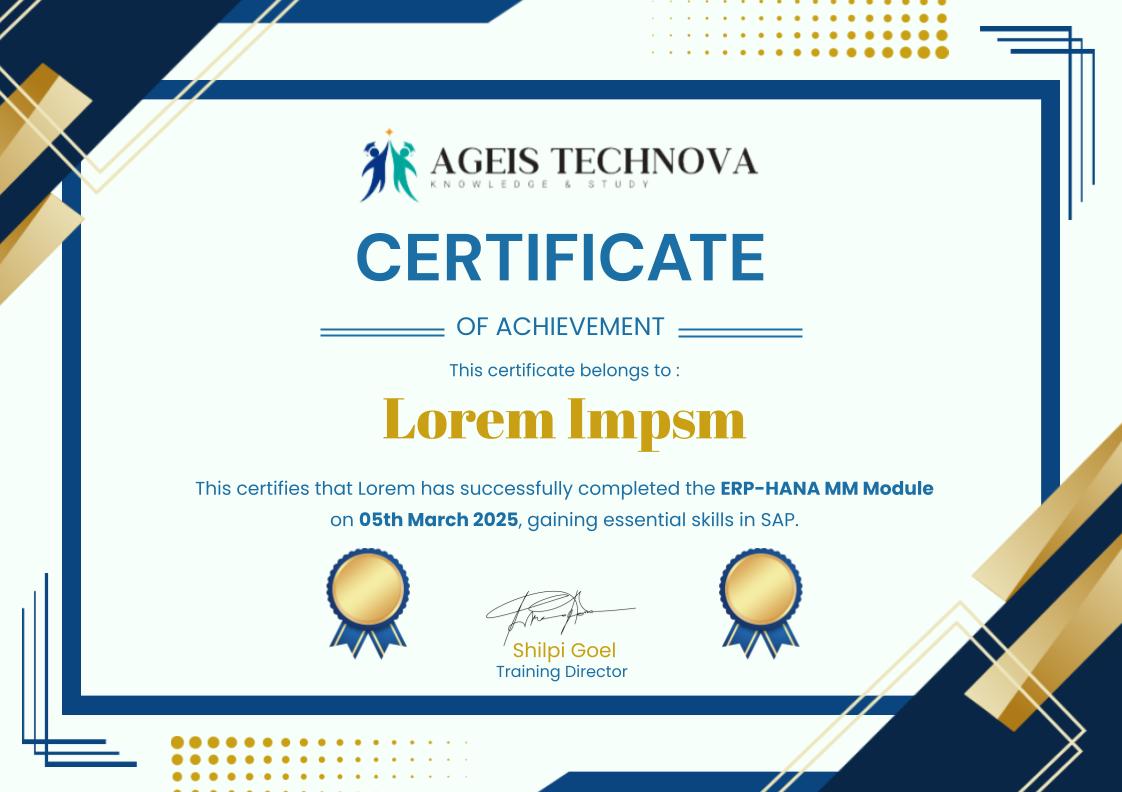Course Features
- 1: 1 Session – Personalized guidance for accelerated learning.
- SAP Fast-Track – Master SAP quickly with an intensive curriculum.
- Weekend & Daily Classes – Flexible learning options to fit your schedule.
- Hands-on Training – Access to real-time SAP systems for practical experience.
- Industry-Relevant Curriculum – Developed by SAP experts to meet current market demands.
- Live Project-Based Training – Gain expertise in SAP configuration and support through real-
time projects.
Duration
Regular Track – 45-60 Days
Weekend Track – 10 Weekends
Fast Track – 5-7 Days
Hours (In a Day)
Regular Track – 1-1:30 hours
Weekend Track – 2-3 hours
Fast Track – 5-6 Hours
Training Mode
Live Classroom
ABAP Training Objectives
- Understand Core Concepts: Learn the fundamentals of SAP ABAP, including syntax, data types, and modularization.
- Develop Custom Applications: Gain skills to develop, test, and deploy custom reports, forms, and interfaces in SAP.
- Work with SAP HANA: Learn to optimize ABAP for SAP HANA using CDS views, AMDPs, and the ABAP RESTful Application Programming Model.
- Enhance Technical Skills: Master debugging, performance tuning, and object-oriented programming in ABAP.

Course Overview:
ERP S.A.P Advanced Business Application Programming (ABAP) training enhances proficiency in utilizing ABAP, a high-level programming language employed for constructing business applications. Acquiring expertise in ABAP can significantly advance one’s career, given that most SAP’s applications and systems are developed using this language. By gaining proficiency in ABAP under the guidance of seasoned professionals, participants will be equipped to develop code for programming or reporting on the Application Server across various modules.
Benefits of Learning ERP S.A.P ABAP:
✅ High-Demand Skills – Master SAP ABAP for top career opportunities.
✅ Career Growth – Qualify for roles like ABAP Developer & SAP Consultant.
✅ Hands-On Learning – Work on real projects, case studies & industry scenarios..
✅ Performance Optimization – Learn CDS views, AMDP & tuning for faster processing.
✅ Future-Ready – Stay ahead with RAP, Fiori & next-gen SAP development.
Who Can Take This Course?
✅ Programmers
✅ Developers
✅ Final year candidates
✅ Any Graduate (BCA)
✅ Any Postgraduate (B.Tech)
Prerequisites
Candidates should possess a solid understanding of basic programming languages, relational databases, and object-oriented concepts to enroll in this SAP ABAP Training.
Skills you will gain after completing the ERP S.A.P ABAP Training:
✅ Gain comprehension of ABAP data types, terminology, and dictionary concepts, encompassing structures, tables, buffers, indexes, etc.
✅ Implement ABAP programming fundamentals to write programs, covering formatting, string/data operations, syntax checking, performance tracing, and additional functionalities.
✅ Utilize modularization techniques such as macros, includes, subroutines, and function modules.
✅ Develop programs utilizing loops and branches.
✅ Construct programs employing module pools, file handling, and scripting.
✅ Explore advanced features including BADI, ALE, IDOC, RFC, ALV, LSMW, and others.
Course Content of ERP S.A.P ABAP:
✅ Module 1 – Introduction to ERP- SAP Overview
✅ Module 2 – SAP ASAP Road map (Implement Strategy)
✅ Module 3 – ABAP Dictionary Concepts
✅ Module 4 – ABAP-Data Types
✅ Module 5 – Loops & Branches
✅ Module 6 -Programming Basics-ABAP
✅ Module 7 – ABAP Structures and Internal Tables
✅ Module 8 – Modularization Techniques
✅ Module 9 – Reports
✅ Module 10 – Module Pools
✅ Module 11 – Dialog Programs
✅ Module 12 – SAP Scripts
✅ Module 13 – Smart Forms
✅ Module 14 – ALE
✅ Module 15 – ALV (ABAP List Viewer)
✅ Module 16 – Work Flow
✅ Module 17 – BAPI
✅ Module 18 – SAP Job Assistance
Certification
Become a certified SAP ABAP professional and gain the skills to build, customize, and enhance SAP S/4HANA systems. Master real-world development tools, coding best practices, and integration techniques essential for ERP success.
- Certificate of Completion
- Assistance with SAP Global Certification (optional)
- Resume preparation & interview guidance
- Placement support with partner firms
Have questions? Need guidance? Don’t hesitate to reach out—we’re here to help you succeed! Call +91-74287 06064
Bonuses & Add-Ons:
- Free access to recorded sessions
- Resume templates & mock interviews
- Interview question bank
- Doubt clearance till 1 year of course completion
About Ageis Technova – Delhi NCR:
Ageis Technova is a premier online learning platform specializing in ERP S.A.P S/4HANA, Data Science, and emerging technologies. We provide expert-led, hands-on training designed to bridge the gap between education and industry, equipping students and professionals with job-ready skills for career success.
- 20+ years experience in SAP consulting
- Certified SAP professionals
- Worked on multiple implementation & support projects
- Real-time case study explanations
With a strong focus on practical learning, certification, and placement support, we empower learners to excel in today’s competitive job market and secure opportunities in top industries.
Contact / Enroll Now
- Call / WhatsApp: +91-74287 06064
- Email:info@ageistechnova.com
- Free Demo Class Available
- Limited Seats per Batch



